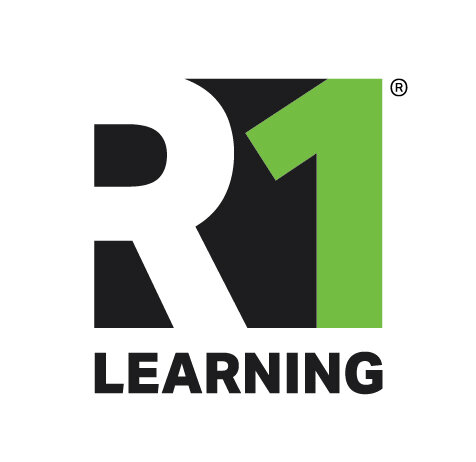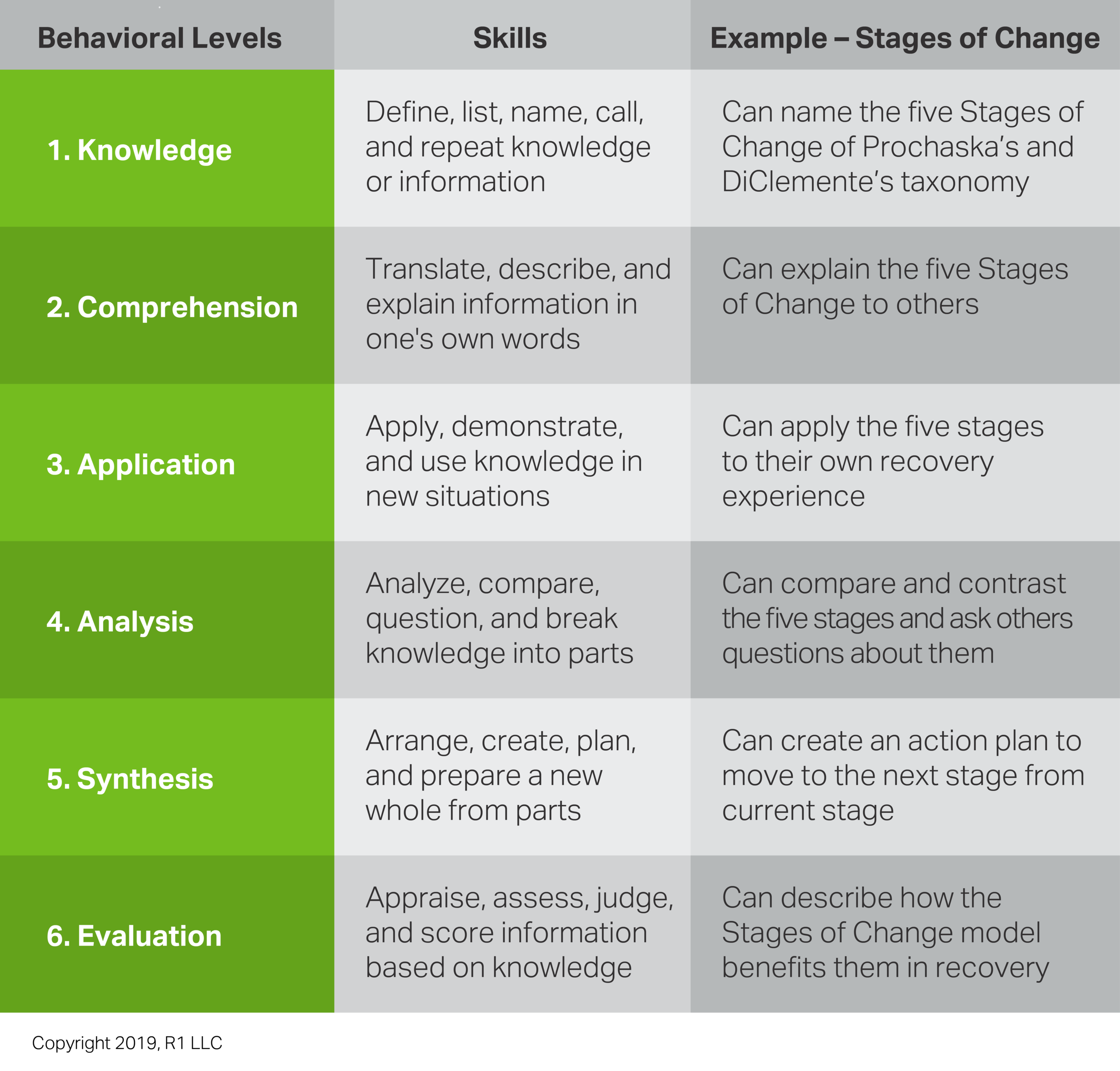6 Levels of Learning for Improving Outcomes – Am I Achieving the Results I Want?
Today’s post is centered in our category of Curriculum. We are going to explore the importance of learning objectives for reaching your goals in psycho-education settings. I attended the National Association of Addiction Treatment Providers (NAATP) annual conference in Washington D.C. this week. Standards for treatment providers were being presented and reviewed after a lot of hard work and industry collaboration. Outcome Measures is on the list but no clear requirements for standardized curriculum as a path toward improved outcomes. Without standardized quality curriculum for programs, especially with multiple locations and multiple clinicians at each location, it is nearly impossible to measure outcomes. How can we understand the impact of our treatment and recovery program if everyone on our team teaches different topics with different learning objectives using different methods? There is a lot to unpack in this question but nothing we have to solve today. We just want you to take a moment to consider this question for yourself.
A typical day in the life of a clinician, coach, or educator – It’s a busy day. You just spent the morning in traffic, barely made it into the office on time, and the first thing on your calendar is to run a group of individuals through one of the topics in your curriculum. You’ve been doing this for years, every group is different, and today, you take a moment to reflect on what you want to accomplish in this next hour. Sometimes this thought comes on your way to work and other days it appears just as the last individual sits down in their group chair. The voice in your head reappears and asks, “what do I want to achieve with this topic this morning?” Today’s topic just happens to be “The Stages of Change” developed by Drs. Prochaska and DiClemente as part of their smoking sensation research back in the early 1980s. We’ll go more into depth about these two geniuses in another post – but at this moment, let’s just thank them for all they’ve done for the field of psychology, substance use disorder, and the broader behavioral health industry.
Back to the room… today is about delivering this information with an intent to teach your audience something about this theory. This may be the first time any of these individuals learned about the 5 Stages of Change and it may be their last time too. It may be something they’ve heard before – maybe they understood it and maybe not. The question I’d like you to think about is what will individuals be able to do as the result of the learning experience you are about to deliver? The answer to this questions drives everything you do. It drives everything you present, handout, say – even the questions you ask. It will ultimately lead to and support the behavioral change you are targeting. If objectives are not clear, then the possibility of achieving your goal is low.
Bloom’s Taxonomy
Are you achieving the results you want? Let’s look at this question through the lens of learning objectives. Bloom’s Taxonomy, the hierarchy of learning outcomes, identifies six behavioral levels of knowledge and skill development as a way instructional designers think about and plan for in their curriculum development. As you read through this chart, what results do you want to achieve in your session? Are you trying to reach just one of these levels, or are there several on the list that you’re targeting?
In 1956, Benjamin Bloom with collaborators Max Englehart, Edward Furst, Walter Hill, and David Krathwohl published a framework for categorizing educational goals: Taxonomy of Educational Objectives. Familiarly known as Bloom’s Taxonomy.
Pretty interesting and helpful… right? Can you see that depending on which behavioral levels and skills you want to develop, it will require focus on what you’re doing and how you’re doing it? As you can imagine, this framework can be used for many purposes. Here are a few we would suggest to help integrate it into your daily practice and improve your program curriculum over time:
For You (if you deliver psycho-education groups):
State the learning objectives you’d like to achieve to yourself before you start each group session. Write it down or type it out for yourself before you start. At the end of the session, review your notes to see if you were able to reach your goal.
Reflect on your session and pinpoint the moments where you observed these objectives being reached. What were the questions you asked or the activity you were working through when these moments of insights arrived? Remember these events so you can replicate them in future sessions?
Share what you learned with the group at the close of your session. Highlight specific examples and thank the group for reaching the learning objectives together. If you have a staff meeting where you share best practices, share some of your learnings with your team. Be as specific as you can as you describe what the stated learning objective are and specific examples of how you achieved them. Lessons learned and lessons shared become best practices overtime and lessons leveraged by others. All ships rise in the harbor when we share lessons learned.
For Your Program:
Clarify the current learning objectives for each module in your curriculum using this framework. See if you have written objectives for each module, and if you do, which level of Bloom’s Taxonomy are you trying to achieve? Which skills are you working to develop? Do this as a team so that all of your clinicians or educators are on the same page. I promise this will be a rich discussion if you have it.
Assess your current curriculum outline, activities, and materials to see if they reflect an appropriate path to reaching these objectives. Will you achieve the stated objectives if you do the things you’re planning to do? If yes – great. If not, how can you change or modify your design to achieve these results?
Update your current module by clarifying what you do want to achieve and exploring the right curriculum design to get you there. Again, do this as a group and work through the details together. These discussions will enhance and improve the consistency and quality of your overall program. You may want to use this as an opportunity to explore new resources and tools to help improve your activities. If you can, invite someone with experience in training and development to be part of these discussions. Asking others with experience for help usually helps. Their expertise could help take you to the next level.
In closing, I hope this post made you think about what you want to make happen in your learning settings. Please look for opportunities to use Bloom’s Taxonomy for yourself and/or with your team. When using this framework with colleagues, rich discussions often result.
Copyright 2023 R1 Publishing LLC / All Rights Reserved. Use of this article for any purpose is prohibited without permission.
More coming on The Experts and Learning Styles in our next posts. In the meantime, please help us with any of the following actions. Otherwise, stay tuned!
Share this blog post with others. (Thank you!)
Start a conversation with your team. Bring this information to your next team meeting or share it with your supervisor. Change starts in conversations. Good luck! Let us know how it goes.
Visit www.R1LEARNING.com to learn more about R1, the Discovery Cards, and how we’re creating engaging learning experiences through self-discovery.


